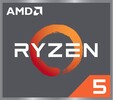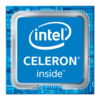AMD Ryzen 5 3500U vs Intel Celeron N5105 vs AMD Ryzen 5 3450U
AMD Ryzen 5 3500U
► remove from comparison
The AMD Ryzen 5 3500U is a mobile SoC that was announced in January 2019. It combines four Zen+ cores (8 threads) clocked at 2.1 GHz to 3.7 GHz with a Radeon RX Vega 8 iGPU with 8 CUs (512 Shaders) clocked at up to 1200 MHz. Specified at 15 Watt TDP, the SoC is intended for thin mid-range laptops. In Chromebooks, AMD calles the APU AMD Ryzen 5 3500C, but the specifications (and performance) are the same.
The Picasso SoC uses the Zen+ microarchitecture with slight improvements that should lead to a 3% IPS (performance per clock) improvements. Furthermore, the 12 nm process allows for higher clocks at similar power consumption.
The integrated dual-channel memory controller supports up to DDR4-2400 memory. As the features of the Picasso APUs are the same compared to the Raven Ridge predecessors, we point to our Raven Ridge launch article.
Performance
The average 3500U in our database matches the Intel Core i7-1065G7 in multi-thread performance to be an OK lower mid-range option, as of early 2021.
The Honor MagicBook 14 is among the fastest laptops powered by the 3500U that we know of. It can be up to 50% faster in CPU-bound workloads than the slowest system featuring the same chip in our database, as of August 2023.
Power consumption
This Ryzen 5 series chip has a default TDP (also known as the long-term power limit) of 15 W, a value that laptop makers are free to set to anything between 12 W and 35 W with clock speeds and performance changing accordingly as a result. Either way, this is a tad too high to allow for passively cooled designs.
The chip is manufactured on a 12 nm process for subpar, as of late 2022, energy efficiency.
Intel Celeron N5105
► remove from comparison
The Intel Celeron N5105 is a quad-core SoC of the Jasper Lake series that is primarily intended for inexpensive desktops and was announced in early 2021. The four Tremont CPU cores clock between 2 and 2.9 GHz (single core Burst) and offer no HyperThreading (SMT). The N5105 uses 1.5 MB L2 and 4 MB L3 cache. The chip is manufactured in 10nm at Intel (most likely in the same process as Ice Lake).
CPU Architecture
The processor architecture is called Tremont and a complete redesign compared to the old Golmont Plus cores in the predecessor. According to Intel, the single thread performance of a core could be improved by 30% on average (10 - 80% in all tests of SPECint and SPECfp).
Features
In addition to the quad-core CPU block, the SoC integrates a 24 EU Intel UHD Graphics GPU clocked from 450 - 800 MHz and a LPDDR4(x) dual channel memory controller (up to 16 GB and 2933 MHz). The chip now also partly integrates Wi-Fi 6 (Gig+), 8 PCIe 3.0 lanes, 14 USB 2.0/ 3.2 ports and two SATA 6.0 ports. The package got bigger and measures 35 x 24 mm (compared to 25 x 24 mm for the N5030 e.g.). The SoC is directly soldered to the mainboard (BGA) and can't be easily replaced.
Performance
The average N5105 in our database is in the same league as the Core i3-1005G1 and the Ryzen 3 3250U, as far as multi-thread benchmark scores are concerned. Your mileage may vary depending on how high the CPU power limits are.
Power Consumption
Similar to the predecessor, Intel specifies the TDP with 10 Watts (mobile and lower clocked N5100 6W). The chip can therefore be cooled passively in theory, but SKUs with fans are possible as well.
AMD Ryzen 5 3450U
► remove from comparison
The AMD Ryzen 5 3450U is a mobile SoC that was announced in Q2 2020 as a refresh. It combines four Zen+ cores (8 threads) clocked at 2.1 GHz to 3.5 GHz (-200 MHz versus 3500U) with a Radeon RX Vega 8 iGPU with 8 CUs (512 Shaders) clocked at up to 1200 MHz.
The Picasso SoC uses the Zen+ microarchitecture with slight improvements that should lead to a 3% IPS (performance per clock) improvements. Furthermore, the 12 nm process allows for higher clocks at similar power consumption.
The integrated dual-channel memory controller supports up to DDR4-2400 memory. As the features of the Picasso APUs are the same compared to the Raven Ridge predecessors, we point to our Raven Ridge launch article.
Performance
The average 3450U in our database is in the same league as the Core i3-1115G4 and also the Ryzen 3 4300U, as far as multi-thread benchmark scores are concerned. This is a better-than-expected result for an aging lower mid-range chip that is the 3450U, as of mid 2022.
Your mileage may vary depending on how high the CPU power limits are and how competent the cooling solution of your system is.
Power consumption
The Ryzen 5 has a default TDP (also known as the long-term power limit) of 15 W, a value that laptop manufacturers are allowed to change to anything between 12 W and 35 W if required with clock speeds and performance changing correspondingly. These values are fairly high, making active cooling solutions something of a necessity.
The CPU is built with a somewhat old, as of late 2022, 12 nm process for lower-than-average energy efficiency.
| Model | AMD Ryzen 5 3500U | Intel Celeron N5105 | AMD Ryzen 5 3450U | ||||||||||||||||||||||||||||||||||||||||||||||||||||||||||||||||||||||||||||||||
| Codename | Picasso-U (Zen+) | Jasper Lake | Picasso-U (Zen+) | ||||||||||||||||||||||||||||||||||||||||||||||||||||||||||||||||||||||||||||||||
| Series | AMD Picasso (Ryzen 3000 APU) | Intel Jasper Lake | AMD Picasso (Ryzen 3000 APU) | ||||||||||||||||||||||||||||||||||||||||||||||||||||||||||||||||||||||||||||||||
| Series: Picasso (Ryzen 3000 APU) Picasso-U (Zen+) |
|
|
| ||||||||||||||||||||||||||||||||||||||||||||||||||||||||||||||||||||||||||||||||
| Clock | 2100 - 3700 MHz | 2000 - 2900 MHz | 2100 - 3500 MHz | ||||||||||||||||||||||||||||||||||||||||||||||||||||||||||||||||||||||||||||||||
| L1 Cache | 384 KB | 384 KB | |||||||||||||||||||||||||||||||||||||||||||||||||||||||||||||||||||||||||||||||||
| L2 Cache | 2 MB | 1.5 MB | 2 MB | ||||||||||||||||||||||||||||||||||||||||||||||||||||||||||||||||||||||||||||||||
| L3 Cache | 4 MB | 4 MB | 4 MB | ||||||||||||||||||||||||||||||||||||||||||||||||||||||||||||||||||||||||||||||||
| Cores / Threads | 4 / 8 | 4 / 4 | 4 / 8 | ||||||||||||||||||||||||||||||||||||||||||||||||||||||||||||||||||||||||||||||||
| TDP | 15 Watt | 10 Watt | 15 Watt | ||||||||||||||||||||||||||||||||||||||||||||||||||||||||||||||||||||||||||||||||
| Transistors | 4500 Million | 4500 Million | |||||||||||||||||||||||||||||||||||||||||||||||||||||||||||||||||||||||||||||||||
| Technology | 12 nm | 10 nm | 12 nm | ||||||||||||||||||||||||||||||||||||||||||||||||||||||||||||||||||||||||||||||||
| max. Temp. | 105 °C | 105 °C | 105 °C | ||||||||||||||||||||||||||||||||||||||||||||||||||||||||||||||||||||||||||||||||
| Socket | FP5 | BGA1338 | FP5 | ||||||||||||||||||||||||||||||||||||||||||||||||||||||||||||||||||||||||||||||||
| Features | DDR4-2400 RAM, PCIe 3, MMX, SSE, SSE2, SSE3, SSSE3, SSE4A, SSE4.1, SSE4.2, AVX, AVX2, BMI2, ABM, FMA, ADX, SMEP, SMAP, SMT, CPB, AES-NI, RDRAND, RDSEED, SHA, SME | DDR4-2933/LPDDR4x-2933 RAM, PCIe 3, GNA, MMX, SSE, SSE2, SSE3, SSSE3, SSE4.1, SSE4.2, VMX, SMEP, SMAP, EIST, TM1, TM2, Turbo, AES-NI, RDRAND, RDSEED, SHA | DDR4-2400 RAM, PCIe 3, MMX, SSE, SSE2, SSE3, SSSE3, SSE4A, SSE4.1, SSE4.2, AVX, AVX2, BMI2, ABM, FMA, ADX, SMEP, SMAP, SMT, CPB, AES-NI, RDRAND, RDSEED, SHA, SME | ||||||||||||||||||||||||||||||||||||||||||||||||||||||||||||||||||||||||||||||||
| iGPU | AMD Radeon RX Vega 8 (Ryzen 2000/3000) ( - 1200 MHz) | Intel UHD Graphics (Jasper Lake 24 EU) (450 - 800 MHz) | AMD Radeon RX Vega 8 (Ryzen 2000/3000) ( - 1200 MHz) | ||||||||||||||||||||||||||||||||||||||||||||||||||||||||||||||||||||||||||||||||
| Architecture | x86 | x86 | x86 | ||||||||||||||||||||||||||||||||||||||||||||||||||||||||||||||||||||||||||||||||
| Announced | |||||||||||||||||||||||||||||||||||||||||||||||||||||||||||||||||||||||||||||||||||
| Manufacturer | www.amd.com | ark.intel.com | www.amd.com |
Benchmarks
Average Benchmarks AMD Ryzen 5 3500U → 100% n=19
Average Benchmarks Intel Celeron N5105 → 66% n=19
Average Benchmarks AMD Ryzen 5 3450U → 91% n=19
* Smaller numbers mean a higher performance
1 This benchmark is not used for the average calculation













